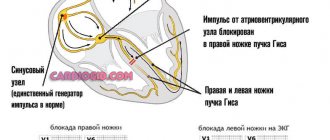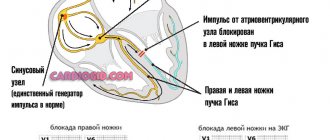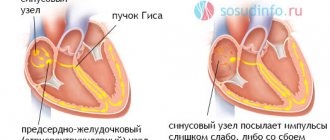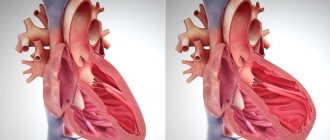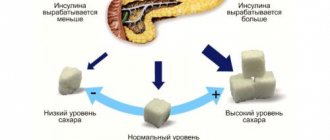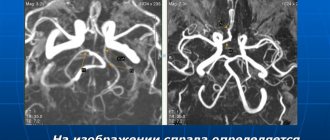Causes
Blockade of the bundle branches or their individual branches can be caused by the following factors:
- Congenital anomalies - narrowing of the aorta or pulmonary artery, departure of blood vessels from the ventricle.
- Previously suffered cardiovascular diseases - atherosclerosis , myocardial infarction, coronary heart disease, etc.
- Impaired heart function as a result of diseases that reduce immunity.
- Heart surgery.
- Bad habits – alcoholism, drug addiction, smoking.
- Hormonal disorders - diabetes mellitus, diseases of the thyroid and pancreas, adrenal glands.
- Hypoxia is an insufficient supply of oxygen to the body caused by diseases of the respiratory system (for example, bronchial asthma).
| Types of blockade | When does it occur |
| Right bundle branch block | For diseases accompanied by hypertrophy and overload of the right ventricle: high blood pressure, coronary heart disease, narrowing of the mitral valve, acute myocardial infarction. |
| Left bundle branch block | For inflammation and disruption of the heart muscle, aortic valve defects. |
| Blockade of both bundle branches at once | With narrowing of the aortic lumen, incomplete closure of the aortic valve. |
In children, bundle branch block develops in utero for the following reasons:
- mother taking insulin during pregnancy;
- pathological development of cardiac septa;
- diffuse damage to connective tissue in the expectant mother.
Symptoms
Many clinical cases of the disease occur without any symptoms. Incomplete single-fascicle blocks almost never show symptoms, so they are detected only by ECG during a routine examination. But with complete blockade of the right leg, symptoms are usually observed in a person even in the absence of organic heart damage. These include:
- various changes when listening to heart sounds;
- dizziness;
- presyncope and fainting;
- feeling of lack of air;
- dyspnea;
- decreased performance;
- poor exercise tolerance;
- fatigue and weakness;
- sometimes pain in the heart area;
- feeling of interruptions in the work of the heart.
In addition, it is possible that a clinical picture will appear that corresponds to the underlying disease - both cardiac and affecting other organs and systems. The most serious symptoms appear in acute cardiac pathologies - heart failure, myocardial infarction, which are most often accompanied by various heart blocks against the background of damage to the ventricular myocardium.
Classification
Cardiac impulse conduction disorders are divided into:
- complete – there is no impulse conduction at all;
- incomplete – impulse conduction is difficult.
Bundle branch block often occurs in seemingly healthy people, including athletes.
Also, blockade of elements of the conduction system of the heart is classified depending on the number of areas where patency is impaired:
- single-bundle – only one leg is affected;
- double-bundle – simultaneous damage to two branches of the His bundle occurs;
- three-bundle – impulse conduction is absent in all branches of the His bundle.
1.General information
The His bundle, as well as blocks of its structural elements, are very often mentioned by cardiologists, especially when interpreting jagged ECG curves. Of course, it would take many years of study of anatomy, neurology, histology, electrochemistry and other complex sciences to thoroughly understand the structure of this intracardiac formation and the features of this or that blockade. However, it is possible and necessary to get a general idea.
If we use standard comparisons of the heart with a “motor” and a “pump,” then this motor is electric (at least with electrical control, since it is the electrical impulses that cause different groups of myocardial muscle fibers to contract in turn).
The clock frequency and sequence of phases (contraction-relaxation, depolarization-repolarization) in each cycle must be strictly observed, and any desynchronization is fraught with an emergency stop - and clinical death. Therefore, the critical pacemaker function, i.e. setting the step and rhythm is carried out with multi-stage security for uninterrupted operation. If the main “clock generator” (sinoatrial node, Kis-Flyak sinus node) fails, its role is taken over by the hierarchically located lower atrioventricular node (atrioventricular), which, in turn, gives rise to a switching “harness” consisting of the same atypical electrically conductive cells and branching into two parts.
In case of failure, even at this level, the individual terminal fibers of this cord (Purkinje fibers) try to take on the pacemaker role - in a word, the conduction system of the heart is built by evolution with the expectation of maximum automatism. And yet, mortality from sudden arrhythmias and fibrillations (chaotic, uncoordinated contractions of myocardial elements) remains very high.
The bundle of His is the same “multi-core cable” that comes out of the atrioventricular node, is located in the interventricular septum and conducts control electrical impulses to the ventricles of the myocardium.
One of its legs, the back one, continues the “main vein” and goes down; the other two legs, right and left, represent a paired branching. However, they are located and arranged much less symmetrically than other paired structures of the body (eyes, kidneys, lungs, etc.). Thus, the right bundle branch is a complete “power line” going to the muscle fibers of the right ventricle, and the left bundle is further divided into anterior and posterior branches. A blockade is a decrease or absence of electrical conductivity in one or more segments of this conductive network. This blockage can occur:
- in the anterior branch of the left bundle branch;
- in the posterior branch of the left bundle branch;
- in one of the above branches plus the right leg;
- in both branches of the left leg (complete blockade of the left bundle branch);
- in the right leg in the absence of other blockades;
- in all of the listed legs and branches simultaneously (atrioventricular block).
A must read! Help with treatment and hospitalization!
Symptoms and signs
The child has
In children, bundle branch block can manifest itself even during intrauterine development, at the stage of formation of the cardiovascular system. The development of pathology is due to both heredity and the woman’s unhealthy lifestyle during pregnancy.
Signs of intracardiac conduction disorders in children:
- decreased physical activity;
- dizziness, weakness;
- chest pressure.
In an adult
The main signs of bundle branch block in adults:
- heart rhythm disturbance;
- dizziness, temporary loss of consciousness;
- shortness of breath, feeling of heaviness in the chest.
In adults, the disease is asymptomatic in most cases. Patients learn about cardiac obstruction when undergoing an ECG during medical examinations.
The appearance of at least one of the above symptoms is a reason to consult a cardiologist. Do not self-medicate by taking medications as recommended by friends.
Traditional treatment
Traditional methods of therapy should be used with extreme caution in childhood. Before using them, it is important to consult with your doctor. Drinks such as a decoction of hawthorn berries, rose hips, and tea made from lemon balm leaves will be beneficial for cardiac activity. As a sedative, you can add motherwort, valerian, viburnum leaves and lingonberry to tea.
Before using any herbs, you should first make sure that your child is not allergic to them. The medication should be started with small amounts. If at this time no negative symptoms arise, then you can safely carry out treatment.
Diagnostics
At the first visit, the doctor collects a patient’s life history, which includes the following information: complaints, symptoms, presence of heart pathologies in the past and methods of their treatment. Next, the specialist measures the heart rate and determines the boundaries of the heart by tapping and listening to the chest. For final diagnosis, the patient is prescribed cardiography and laboratory tests (blood test: general and for hormones).
To obtain a more complete clinical picture, additional examinations are prescribed:
- Ultrasound is a study that allows you to identify heart diseases that caused the blockage.
- Transesophageal electrophysiological study - simultaneous stimulation of the heart with electronic pulses is performed and the results are displayed on the cardiogram.
- Holter monitoring – the patient wears an ECG device throughout the day and records his actions. The doctor analyzes the situations in which cardiac conduction disturbances occurred.
When collecting a medical history from a child, you will need to provide the doctor with information about the mother’s health during pregnancy and find out whether there is a hereditary predisposition to diseases of the cardiovascular system.
Is it possible to serve in the army and play sports?
NBPBB is not considered a pathology for which military service is prohibited. This, of course, does not apply to cases of severe disease with various additional disorders of internal organs and systems.
As for sports, physical activity is allowed if the person is in good health, but it is still better to exclude too intense physical activity and strength sports.
Treatment
Treatment for bundle branch block is prescribed individually for each patient, depending on the final diagnosis, the presence of contraindications and general health.
The child has
If a child is diagnosed with a violation of the conduction of cardiac impulses, the cause should be identified and undergo a course of treatment under the supervision of a cardiologist. If parents notice a sharp weakness in the child, pale skin and complaints of pressure in the chest, they should lay the baby on his back, call an ambulance and perform breathing exercises. Take a deep breath, hold the breath for a few seconds, then exhale slowly. The exercise is repeated several times.
Treatment of diseases of the cardiovascular system is primarily aimed at eliminating symptoms that interfere with a healthy lifestyle. Together with drug therapy, the child is prescribed a course of vitamins and restoratives.
In an adult
Like children, adults, when a bundle branch block is detected, specific drug therapy is prescribed. You should not change or stop taking medications on your own, even if you feel better.
If drug therapy is unsuccessful and the patient’s well-being does not return to normal, surgical intervention to install a pacemaker is prescribed.
During treatment, it is important not only to take the medications prescribed by your doctor, but also to adhere to your diet. Avoid fatty and fried foods and include more fiber-containing foods (strawberries, cereals, bran) in your diet.
Forecast
{banner_banstat10}
Depends on a number of factors. Favorable points associated with good survival:
- Complete or predominant absence of symptoms and clinical picture.
- Normal state of health (without somatic pathologies).
- High-quality response to treatment.
- Young age.
- Good family history.
- No bad habits. Incidental detection of an abnormality on electrocardiography.
Mortality is maximum with complete three-bundle blocks and reaches 80%. Bradycardia is the main factor in cardiac arrest. Heart attacks and strokes occur less frequently.
The prognosis for restoration of working capacity is relatively favorable. But you can safely forget about physical work. The likelihood of death due to mechanical overload increases sharply.

